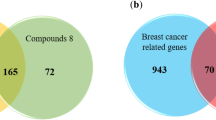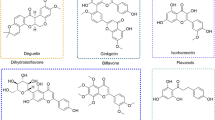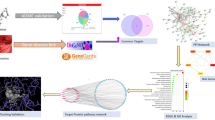Abstract
Objective
To explore the potential mechanism of Yishen Qutong Granules (YSQTG) for the treatment of esophageal cancer using network pharmacology and experimental research.
Methods
The effective components and molecular mechanism of YSQTG in treating esophageal cancer were expounded based on network pharmacology and molecular docking. The key compound was identified by high-performance liquid chromatography and mass spectrometry (HPLC-MS) to verify the malignant phenotype of the key compounds in the treatment of esophageal cancer. Then, the interaction proteins of key compounds were screened by pull-down assay combined with mass spectrometry. RNA-seq was used to screen the differential genes in the treatment of esophageal cancer by key compounds, and the potential mechanism of key compounds on the main therapeutic targets was verified.
Results
Totally 76 effective compounds of YSQTG were found, as well as 309 related targets, and 102 drug and disease interaction targets. The drug-compound-target network of YSQTG was constructed, suggesting that quercetin, luteolin, wogonin, kaempferol and baicalein may be the most important compounds, while quercetin had higher degree value and degree centrality, which might be the key compound in YSQTG. The HPLC-MS results also showed the stable presence of quercetin in YSQTG. By establishing a protein interaction network, the main therapeutic targets of YSQTG in treating esophageal cancer were Jun proto-oncogene, interleukin-6, tumor necrosis factor, and RELA proto-oncogene. The results of cell function experiments in vitro showed that quercetin could inhibit proliferation, invasion, and clonal formation of esophageal carcinoma cells. Quercetin mainly affected the biological processes of esophageal cancer cells, such as proliferation, cell cycle, and cell metastasis. A total of 357 quercetin interacting proteins were screened, and 531 genes were significantly changed. Further pathway enrichment analysis showed that quercetin mainly affects the metabolic pathway, MAPK signaling pathway, and nuclear factor kappa B (NF- κ B) signaling pathway, etc. Quercetin, the key compound of YSQTG, had stronger binding activity by molecular docking. Pull-down assay confirmed that NF- κ B was a quercetin-specific interaction protein, and quercetin could significantly reduce the protein level of NF- κ B, the main therapeutic target.
Conclusion
YSQTG can be multi-component, multi-target, multi-channel treatment of esophageal cancer, it is a potential drug for the treatment of esophageal cancer.
Similar content being viewed by others
Data Availability
The data used to support the findings of this study are included within the article and the supplementary information files.
References
Zheng RS, Zhang SW, Zeng HM, Wang SM, Sun KX, Chen R, et al. Cancer incidence and mortality in China, 2016. J Nat Cancer Center 2022;2:1–9.
Pennathur A, Gibson MK, Jobe BA, Luketich JD. Oesophageal carcinoma. Lancet 2013;381:400–412.
Chen W, Zheng R, Baade PD, Zhang S, Zeng H, Bray F, et al. Cancer statistics in China, 2015. Cancer J Clin 2016;66:115–132.
Taylor PR, Li B, Dawsey SM, Li JY, Yang CS, Guo W, Blot WJ. Prevention of esophageal cancer: the nutrition intervention trials in Linxian, China. Linxian Nutrition Intervention Trials Study Group. Cancer Res 1994;54:2029s–2031s.
Swisher SG, Wynn P, Putnam JB, Mosheim MB, Correa AM, Komaki RR, et al. Salvage esophagectomy for recurrent tumors after definitive chemotherapy and radiotherapy. J Thorac Cardiovasc Surg 2002;123:175–183.
Ishikura S, Nihei K, Ohtsu A, Boku N, Hironaka S, Mera K, et al. Long-term toxicity after ddefinitive chemoradiotherapy for squamous cell carcinoma of the thoracic esophagus. J Clin Oncol 2003;21:2697–2702.
Zhou L, Feng L. Clinical study of Yishen Gukang Prescription combined with hyperthermia and Western medicine in the treatment of pain in patients with bone metastases. Chin J Tradit Chin Med (Chin) 2015;12:62–65.
Yin Y, Feng L, Zhou L, Li J, Gao Y, Wang N, et al. Effects of Yishen Gukang Decoction on expression of bone-specific alkaline phosphatase, carboxyterminal propeptide of type I procollagen, cross-linked telepeptide of type I collagen in malignant tumor patients with bone metastasis. Chin J Tradit Chin Med (Chin) 2017;37:30–34.
Kim TW, Lee SY, Kim M, Cheon C, Ko SG, et al. Kaempferol induces autophagic cell death via IRE1-JNK-CHOP pathway and inhibition of G9a in gastric cancer cells. Cell Death Dis 2018;9:875.
Phan T, Nguyen VH, A’lincourt Salazar M, Wong P, Diamond DJ, Yim JH, et al. Inhibition of autophagy amplifies baicalein induced apoptosis in human colorectal cancer. Mol Ther Oncolytics 2020;19:1–7.
Wang ZX, Ma J, Li XY, Wu Y, Shi H, Chen Y, et al. Quercetin induces p53-independent cancer cell death through lysosome activation by the transcription factor EB and reactive oxygen species-dependent ferroptosis. Br J Pharmacol 2021;178:1133–1148.
Hashemzaei M, Far AD, Yari A, Heravi RE, Tabrizian K, Taghdisi SM, et al. Anticancer and apoptosis inducing effects of quercetin in vitro and in vivo. Oncol Rep 2017;38:819–828.
Hopkins, Andrew L. Network pharmacology: the next paradigm in drug discovery. Nature Chem Biol 2008;4:682–690.
Barabási AL, Oltvai ZN. Network biology: understanding the cell’s functional organization. Nature Rev Genetics 2004;5:101–113.
Guo Y, Chen X, Qi J, Yu B. Simultaneous qualitative and quantitative analysis of flavonoids and alkaloids from the leaves of Nelumbo nucifera Gaertn. using highperformanceliquid chromatography with quadrupole time of flight mass spectrometry. J Separat Sci 2016;39:2499–507.
Hanahan D, Weinberg RA. Hallmarks of cancer: the next generation. Cell 2011;144:646.
Xiang Y, Guo Z, Zhu P, Chen J, Huang Y. Traditional Chinese medicine as a cancer treatment: modern perspectives of ancient but advanced science. Cancer Med 2019;8:1958–1975.
Wang S, Long S, Deng Z, Wu W. Positive role of Chinese herbal medicine in cancer immune regulation. Am J Chin Med 2020;48:1577–1592.
Da CH, Pei GX. Network pharmacology: a rosetta stone for traditional Chinese medicine. Drug Develop Res 2015;75:299–312.
Luo TT, Lu Y, Yan SK, Xiao X, Rong XL, Guo J. Network pharmacology in research of Chinese medicine formula: methodology, application and prospective. Chin J Integr Med 2020;26:74–82.
Xu L, Zhang W, Zeng L, Jin JO. Rehmannia glutinosa polysaccharide induced an anti-cancer effect by activating natural killer cells. Int J Biol Macromol 2017;105:680–685.
Telang NT, Nair HB, Wong GYC. Growth inhibitory efficacy of Cornus officinalis in a cell culture model for triple-negative breast cancer. Oncol Lett 2019;17:5261–5266.
Gu G, Barone I, Gelsomino L, et al. Oldenlandia diffusa extracts exert antiproliferative and apoptotic effects on human breast cancer cells through ER alpha/Sp1-mediated p53 activation. J Cell Physiol 2012;227:3363–3372.
Song HY, Han JM, Byun EH, Kim WS, Seo HS, Byun EB. Bombyx batryticatus protein-rich extract induces maturation of dendritic cells and Th1 polarization: a potential immunological adjuvant for cancer vaccine. Molecules 2021;26:476.
Kwon MJ, Kim JN, Park J, Kim YT, Lee MJ, Kim BJ. Alisma canaliculatum extract affects AGS gastric cancer cells by inducing apoptosis. Int J Med Sci 2021;18:2155–2161.
Cheng CS, Chen JX, Tang J, Geng YW, Zheng L, Lv LL. Paeonol inhibits pancreatic cancer cell migration and invasion through the inhibition of TGF- β 1/Smad signaling and epithelial-mesenchymal-transition. Cancer Manag Res 2020;12:641–651.
Jiang WG, Sanders AJ, Katoh M, Ungefroren H, Gieseler F, Prince M, et al. Tissue invasion and metastasis: molecular, biological and clinical perspectives. Semin Cancer Biol 2015;35:S244–S275.
Xin Z, Wu X, Ji T, Xu B, Han Y, Sun M, et al. Bakuchiol: a newly discovered warrior against organ damage. Pharmacol Res 2019;141:208–213.
Mantovani A, Allavena P, Sica A, Balkwill F. Cancer-related inflammation. Nature 2008;454:436–444.
Elinav E, Nowarski R, Thaiss CA, Hu B, Jin C, Flavell RA. Inflammation-induced cancer: crosstalk between tumours, immune cells and microorganisms. Nature Rev Cancer 2013;13:759–771.
Selvakumar P, Badgeley A, Murphy P, Anwar H, Sharma U, Lawrence K, et al. Flavonoids and other polyphenols act as epigenetic modifiers in breast cancer. Nutrients 2020;12:761.
Oteiza PI, Fraga CG, Mills DA, Taft DH. Flavonoids and the gastrointestinal tract: local and systemic effects. Mol Aspect Med 2018;S0098299717301590.
Sun L, Zhao W, Li J, Taft DH. Dietary flavonoid intake and risk of esophageal squamous cell carcinoma: a population-based case-control study. Nutrition 2021;89:111235.
Davoodvandi A, Shabani Varkani M, Clark CCT, Jafarnejad S. Quercetin as an anticancer agent: focus on esophageal cancer. J Food Biochem 2020;44:e13374..
Liu Y, Li CL, Xu QQ, Cheng D, Liu KD, Sun ZQ. Quercetin inhibits invasion and angiogenesis of esophageal cancer cells. Pathol Res Pract 2021;222:153455.
Zhang DW, Shao J, Lin J, Zhang N, Lu BJ, Lin SC, et al. RIP3, an energy metabolism regulator that switches TNF-α induced cell death from apoptosis to necrosis. Science 2009;325:332–336.
Wang X, Liu R, Qu X, Yu H, Chu H, Zhang Y, et al. α-Ketoglutarate-activated NF- κ B signaling promotes compensatory glucose uptake and brain tumor development. Molecular Cell 2019;76:148–162.e7.
Kaneda MM, Messer KS, Ralainirina N, Li H, Leem CJ, Gorjestani S. PI3Kγ is a molecular switch that controls immune suppression. Nature 2016;539:437–442.
Nguyen DP, Li J, Tewari AK. Inflammation and prostate cancer: the role of interleukin 6 (IL-6). BJU Int 2014;113:986–992.
Taniguchi K, Karin M. NF-kappaB, inflammation, immunity and cancer: coming of age. Nat Rev Immunol 2018;18:309–324.
Yong HY, Koh MS, Moon A. The p38 MAPK inhibitors for the treatment of inflammatory diseases and cancer. Expert Opin Investig Drugs 2009;18:1893–1905.
Liu Y, Chen X, Cheng R, Yang F, Yu M, Wang C, et al. The Jun/miR-22/HuR regulatory axis contributes to tumourigenesis in colorectal cancer. Mol Cancer 2018;17:11.
Ediriweera MK, Tennekoon KH, Samarakoon SR. Role of the PI3K/AKT/mTOR signaling pathway in ovarian cancer: biological and therapeutic significance. Semin Cancer Biol 2019;59:147–160.
Ma C, Zu X, Liu K, Bode AM, Dong Z, Liu Z, et al. Knockdown of pyruvate kinase M inhibits cell growth and migration by reducing NF-κ B activity in triple-negative breast cancer cells. Mol Cells 2019;42:628–636.
Ren F, Zhang W, Lu S, Ren H, Guo Y. NRSN2 promotes breast cancer metastasis by activating PI3K/AKT/mTOR and NF-kappaB signaling pathways. Oncol Lett 2020;19:813–823.
Ren D, Yang Q, Dai Y, Guo W, Du H, Song L, et al. Oncogenic miR-210-3p promotes prostate cancer cell EMT and bone metastasis via NF-kappaB signaling pathway. Mol Cancer 2017;16:117.
Wa Q, Huang S, Pan J, Tang Y, He S, Fu X, et al. miR-204-5p represses bone metastasis via inactivating NF-kappaB signaling in prostate cancer. Mol Ther Nucleic Acids 2019;18:567–579.
Li W, Zhang L, Guo B, Deng J, Wu S, Li F, et al. Exosomal FMR1-AS1 facilitates maintaining cancer stem-like cell dynamic equilibrium via TLR7/NFkappaB/c-Myc signaling in female esophageal carcinoma. Mol Cancer 2019;18:22.
Author information
Authors and Affiliations
Contributions
Feng L and Li J conceived and designed the research, and collected the data and drafted the manuscript. Jiang ZL and Yin YK contributed to the study design. Chang JY and Li H analyzed the data and provided valuable suggestions on the investigation. Chen JY and Jin W assisted the conduction of the trials and the improvement of the test protocol, critically reviewed the manuscript and assisted in the final write-up of the manuscript. All authors read and approved the final manuscript.
Corresponding author
Ethics declarations
The authors declare that they have no conflicts of interest.
Additional information
Supported by the National Natural Science Foundation of China (No. 81873283)
Supplementary material to
11655_2022_3677_MOESM1_ESM.pdf
Network Pharmacology and in vitro Experimental Verification on Intervention of Quercetin, Present in Chinese Medicine Yishen Qutong Granules, on Esophageal Cancer
Rights and permissions
About this article
Cite this article
Li, J., Chang, Jy., Jiang, Zl. et al. Network Pharmacology and in vitro Experimental Verification on Intervention of Quercetin, Present in Chinese Medicine Yishen Qutong Granules, on Esophageal Cancer. Chin. J. Integr. Med. 29, 233–243 (2023). https://doi.org/10.1007/s11655-022-3677-6
Accepted:
Published:
Issue Date:
DOI: https://doi.org/10.1007/s11655-022-3677-6




